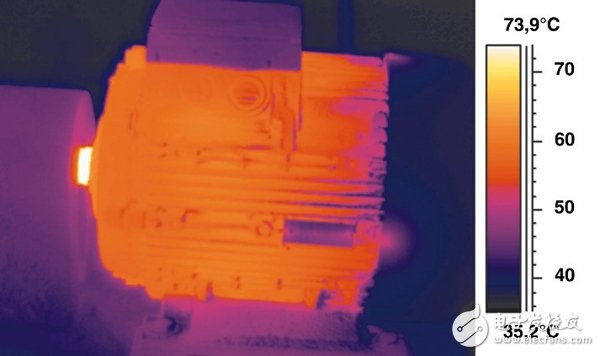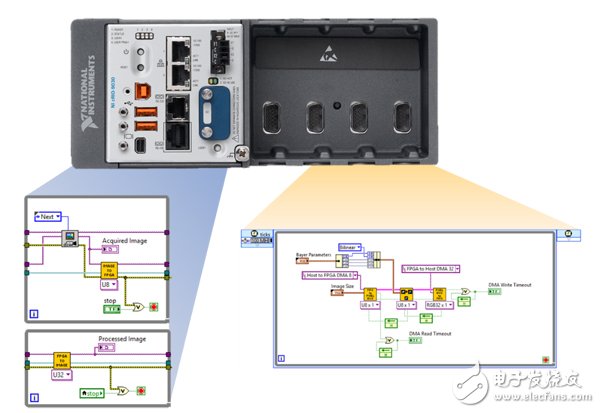The NI CompactRIO platform provides the industry's first programmable automation controllers (PACs) for built-in vision and a fully integrated, efficient design to reduce time-to-market and system size. Board-level options and rugged modular controllers support USB and Gigabit Ethernet-based camera connectivity. The CompactRIO platform can also be used in conjunction with the NI Vision Development Module to accelerate the development of embedded vision applications. The NI Vision Development Module includes a number of image processing functions that run on real-time processors and FPGAs.
ApplicationImage support for the CompactRIO platform addresses a range of control and measurement applications involving mixed I/O, including:
Autonomous robot
By integrating sensor connectivity, vision, motion and control functions in a single system, camera connectivity makes CompactRIO a platform for developing professional robotics projects.
Embedded medical device
Image acquisition and a compact form factor provide an ideal platform for film scanners and automated microscopes, while real-time operating system options make FDA (Food and Drug Administration) certification easier.
Industrial monitoring
Machine vision capabilities also make CompactRIO a platform for industrial applications, including machine condition monitoring and critical pipeline monitoring based on face-scan cameras and thermal imaging cameras.

Figure 2: More useful information can be added for machine condition monitoring by adding thermal imaging to trend hotspots.
2. Camera connectionAdding visual data helps the system more fully understand the environment. In many machines, the vision system is separate from the host controller and the resulting data is transmitted via serial or Ethernet communication. However, many modern applications require lower latency, smaller size, or lower power consumption than distributed systems. CompactRIO's advanced control features, combined with on-board image acquisition and processing, enable tight synchronization between vision and I/O. With Gigabit Ethernet and USB-based camera connectivity, CompactRIO hardware can now connect to thousands of industrial cameras.
The CompactRIO controller's high-performance family is based on Intel Atom and Intel Core i7 processors and supports GigE vision cameras. The GigE vision camera offers cable lengths of up to 400 meters and bandwidths up to 1 Gb/s. For monitoring applications, compressed images can be captured by an IP camera connected to any CompactRIO terminal with an Ethernet port. All CompactRIO and NI Single-Board RIO terminals with USB ports are capable of capturing images from compatible USB3 vision cameras. Why is the USB3 vision camera using a USB 2.0 port? The USB3 Vision Camera provides an industry standard for camera interfaces through which NI Vision Capture software connects hundreds of USB3 vision cameras on the market. Machine vision camera manufacturers are rapidly adopting this standard, so the application of the USB3 vision camera is expected to be as broad as the GigE vision camera. Although the standard is designed for USB 3.0 ports, the standard also includes a backward compatible USB 2.0 port option, and many CompactRIO terminals use a USB 2.0 port. Compatible cameras include the Basler USB3 vision camera and any USB3 vision camera that is backward compatible with the USB 2.0 port. The ability to connect to a variety of USB3 vision cameras, GigE vision cameras and IP cameras offers many instant imaging options for current CompactRIO terminals and users.
Because the NI-IMAQdx driver allows you to edit code without changing the application requirements, no matter which CompactRIO terminal or camera interface you use, you ensure a consistent software experience.
3. FPGA image coprocessingMany image processing algorithms can take advantage of the parallelism of FPGAs and offload processor-intensive tasks in visual applications, freeing up the processor to handle other tasks. The Vision Development Module contains over 50 FPGA image processing functions and APIs to efficiently handle image transfers between the processor and the FPGA. This allows the FPGA to act as a coprocessor that sends processed images back to the host or for image processing to closely match other processing tasks and I/O on the FPGA. This provides a high performance solution for applications such as visual servo control.

Figure 3: Faster visual capabilities by offloading image processing tasks to the FPGA.
Users can use the NI Vision Assistant to quickly create prototypes and develop FPGA vision applications. The NI Vision Assistant is included in the Vision Development Module. Visual Assist is a configuration-based prototyping tool that enables developers to repeatedly execute image processing algorithms to see how parameter changes affect images. After the algorithm is run, the Vision Assistant automatically generates a complete NI LabVIEW project that includes support elements such as host processor VIs, FPGA VIs, and code to transfer images between the processor, FPGA, and the corresponding FIFO. The FPGA code generated by the Vision Assistant is also optimized for parallel execution, and users can modify the image processing algorithms using the LabVIEW FPGA IP Generator in the NI LabVIEW FPGA Module.
4. Recommended hardware and software Recommended Hardware: NI CompactRIO High Performance Controller Recommended Image Acquisition Driver: NI-IMAQdx in Visual Acquisition Software released in September 2014 or later
Recommended Image Processing Software: NI Vision Development Module
Safety Light Curtain,Safety Curtain,Laser Safety Light Curtain,Safety Optic Light Curtain,Security Light Curtain,Press Brake Safety Light Curtains
Jining KeLi Photoelectronic Industrial Co.,Ltd , https://www.sdkelien.com
